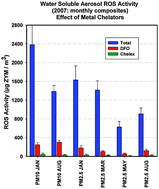Reactive oxygen species activity and chemical speciation of size-fractionated atmospheric particulate matter from Lahore, Pakistan: an important role for transition metals†
Abstract
In this study a sensitive

* Corresponding authors
a
Environmental Chemistry and Technology Program, University of Wisconsin-Madison, 660 North Park Street, WI, USA
E-mail:
mmshafer@wisc.edu
Fax: +1 608 262 0454
Tel: +1 608 217 7500
b Environmental Toxicology Department, Wisconsin State Laboratory of Hygiene, 2601 Agriculture Drive, Madison, WI, USA
c Institute of Environmental Engineering and Research, University of Engineering and Technology, G.T. Road, Lahore, Pakistan
In this study a sensitive

 Please wait while we load your content...
Something went wrong. Try again?
Please wait while we load your content...
Something went wrong. Try again?
M. M. Shafer, D. A. Perkins, D. S. Antkiewicz, E. A. Stone, T. A. Quraishi and J. J. Schauer, J. Environ. Monit., 2010, 12, 704 DOI: 10.1039/B915008K
To request permission to reproduce material from this article, please go to the Copyright Clearance Center request page.
If you are an author contributing to an RSC publication, you do not need to request permission provided correct acknowledgement is given.
If you are the author of this article, you do not need to request permission to reproduce figures and diagrams provided correct acknowledgement is given. If you want to reproduce the whole article in a third-party publication (excluding your thesis/dissertation for which permission is not required) please go to the Copyright Clearance Center request page.
Read more about how to correctly acknowledge RSC content.
 Fetching data from CrossRef.
Fetching data from CrossRef.
This may take some time to load.
Loading related content
